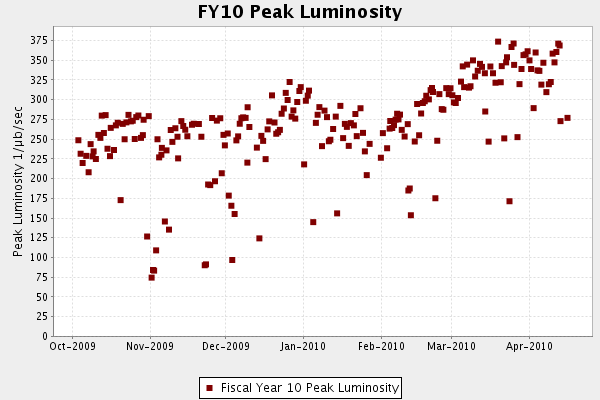Instantaneous luminosity is a measure of the number of collisions of the colliding beams. It basically depends on the number of particles contained in "packets" circulating in the two opposite directions, the rate at which the packets intersect their orbits in the core of the detectors, and the transverse size of the region where the intersection occurs. One gets higher instantaneous luminosity by managing to get more particles in stable orbits, by increasing the rate of their crossing, and by squeezing the beams in the points where they cross.
Instantaneous luminosity may be labeled with the letter L. It is measured in units of units per area per time, such that a higher L means that more particles are crossing a given area in a given time. If luminosity is high, so is the rate at which interesting events are collected by the experiments.
Let me mention what was the record that the Tevatron broke today. The instantaneous luminosity it reached was
 . At that luminosity, and with the energy of the collisions, about ten W bosons are produced per second. And W bosons are the starting point for many exciting searches of new physics, as well as signatures of possible Higgs boson decays, top quark decays, and a stringent probe of the standard model.
. At that luminosity, and with the energy of the collisions, about ten W bosons are produced per second. And W bosons are the starting point for many exciting searches of new physics, as well as signatures of possible Higgs boson decays, top quark decays, and a stringent probe of the standard model.
Above is the up-to-date graph of the instantaneous luminosity performance of the machine. Note that the new point has not been added to the graph yet. And note that they will now need to change the vertical scale to include it -expressed in inverse microbarns (the units of the vertical scale), the new result is 404, an 8% increase from the previous record! The upward jump was quite significant and unexpected -by all but the machinists who made it possible, of course.
With the Tevatron running so well, one wonders whether the US Department of Energy might reconsider their decision to stop the machine at the end of 2011. I have written elsewhere that after delivering 10 inverse femtobarns of collisions to the CDF and DZERO experiments, it would not make much sense to run for one additional year - the increase would just be of 20% of data. But what if they ran for three more years at this unprecedented luminosity ?



Comments